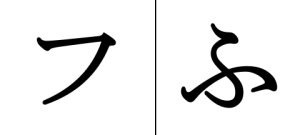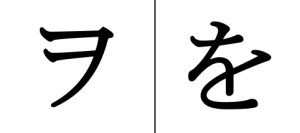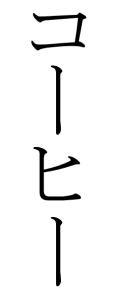4.1 Introduction to Katakana
Welcome to the next step in your Japanese language learning! As you continue mastering hiragana, you will now be introduced to another essential script: カタカナ (katakana).
What is katakana?
Like hiragana, katakana consists of 46 basic characters that represent distinct sounds in Japanese:
| ア (a) | カ (ka) | サ (sa) | タ (ta) | ナ (na) | ハ (ha) | マ (ma) | ヤ (ya) | ラ (ra) | ワ (wa) |
| イ (i) | キ (ki) | シ (shi) | チ (chi/ti) | ニ (ni) | ヒ (hi) | ミ (mi) | リ (ri) | ||
| ウ (u) | ク (ku) | ス (su) | ツ (tsu) | ヌ (nu) | フ (fu/hu) | ム (mu) | ユ (yu) | ル (ru) | ヲ (o) |
| エ (e) | ケ (ke) | セ (se) | テ (te) | ネ (ne) | ヘ (he) | メ (me) | レ (re) | ||
| オ (o) | コ (ko) | ソ (so) | ト (to) | ノ (no) | ホ (ho) | モ (mo) | ヨ (yo) | ロ (ro) | ン (n) |
Please note that in this textbook, チ and フ are represented as chi and fu, respectively, following the Hepburn system of romanisation. However, in some romanisation systems, they might be represented as ti and hu, respectively.
In this book, you will encounter katakana words along the way, and we will provide the corresponding hiragana readings to support your learning.
Let’s start by understanding what katakana is and how it functions within Japanese sentences.
When to use katakana
Katakana is primarily used to transcribe loanwords, that is, words from other languages except for Chinese, into Japanese. It is also used for onomatopoeic words, scientific and technical terms, and certain personal and place names. A practical example of katakana usage is seen on street signboards:
Figure 1: People Walking on Road
What katakana looks like
In terms of appearance, katakana characters have sharper corners and a more angular shape compared to hiragana characters:
| Romaji | Katakana Hiragana |
| fu |  |
| o |  |
Long vowel sounds in katakana
Another notable difference between hiragana and katakana is its method of transcribing long vowels. In katakana, the symbol ‘ー’ is used to indicate long vowels. For example:
The word ‘coffee’ is written in katakana as ‘コーヒー’ (koohii), rather than in hiragana (こおひい), as it is a loanword.
When writing or typing katakana words with long vowels, the symbol ‘ー’ should be presented vertically like this:

Similarities between katakana and hiragana
Even though katakana is different from hiragana, there is some good news.
First of all, similar to hiragana, katakana has additional characters that represent double consonants and contracted sounds, as well as characters with diacritical marks. So, in terms of functionality, katakana works in the same way as hiragana. Here are a few examples:
| Romaji | Hiragana | Katakana | |
| Diacritical Marks | ba・pa | ば ・ ぱ | バ・パ |
| Contracted Sounds | kya | きゃ | キャ |
| Double Consonants | matchi | まっち | マッチ |
Second, some katakana characters look similar to their hiragana counterparts, but with sharper lines. Here are a few examples:
| Romaji | Hiragana | Katakana |
| he | へ | ヘ |
| ri | り | リ |
| ka | か | カ |
| ni | に | ニ |
Basic katakana practice
Although our main emphasis in this book is on mastering hiragana, it is important to be aware of katakana words used in sentences. To help you practise recognising katakana characters, try the exercise below using the katakana chart provided:
| ア (a) | カ (ka) | サ (sa) | タ (ta) | ナ (na) | ハ (ha) | マ (ma) | ヤ (ya) | ラ (ra) | ワ (wa) |
| イ (i) | キ (ki) | シ (shi) | チ (chi/ti) | ニ (ni) | ヒ (hi) | ミ (mi) | リ (ri) | ||
| ウ (u) | ク (ku) | ス (su) | ツ (tsu) | ヌ (nu) | フ (fu/hu) | ム (mu) | ユ (yu) | ル (ru) | ヲ (o) |
| エ (e) | ケ (ke) | セ (se) | テ (te) | ネ (ne) | ヘ (he) | メ (me) | レ (re) | ||
| オ (o) | コ (ko) | ソ (so) | ト (to) | ノ (no) | ホ (ho) | モ (mo) | ヨ (yo) | ロ (ro) | ン (n) |
Here is a downloadable PDF chart for practising basic katakana:
Basic Katakana Chart Japanese Introductory 1 (PDF 60.2 KB)
Exercise 1
Can you match the corresponding hiragana and katakana characters that share the same syllables? Click on the panel and identify the equivalent hiragana or katakana character.
NOTE: Only the katakana panels provide audio as a hint.
Writing and typing your name in katakana
If your name is not of Japanese origin, you will be expected to transcribe it in katakana, rather than hiragana or kanji, particularly in official documents. Here are some tips for writing and typing your name in katakana:
Tip 1. Check the pronunciation
Before writing a non-Japanese name in katakana, make sure you know the correct pronunciation of the name. Katakana is a phonetic script, so it is important to accurately transcribe the sounds of the name.
Tip 2. Double-check the spelling
Make sure you have spelled your name in hiragana correctly before writing it in katakana. Katakana does not have separate characters for the letters ‘r’ or ‘v’, so you may need to substitute them with other characters that sound similar, such as ‘l’ or ‘b’, respectively.
So, for example, the English name ‘Kevin’ is transcribed in Japanese as ケビン (Kebin) instead of ケヴィン (Kevin). This is due to the absence of a native ‘v’ sound in Japanese. The language typically substitutes the ‘v’ with the closest equivalent, the ‘b’ sound, to fit its phonetic system. Such adaptations of foreign sounds to match the available sounds in Japanese are common.
Tip 3. Practise writing and typing
Writing and typing in katakana takes practice, so take some time to practise writing and typing non-Japanese names.
If you are struggling to convert your name into katakana, don’t worry! There are online tools available to help you out. But keep in mind that not all of these tools are 100% accurate, so it might be a good idea to ask a Japanese speaker for some extra help if you can.
Online Japanese name converters
- Clegg, Simon. “Japanese Name Converter.” Developed by Nolan Lawson. Accessed August 13, 2023. https://japanga.com/name-converter.
- John, Mitch. “Translate Your Name into Japanese Katakana.” Last updated January 29, 2023. Accessed August 13, 2023. https://yourkatakana.com/.
Figures
1 “People Walking on Road” (untitled) by Aleksandar Pasaric. Pexels. Licensed under Pexels licence.
2 “Exclamation Sign Icon” (untitled) by Dave Gandy. Wikimedia Commons. Licensed under CC by SA 3.0.

